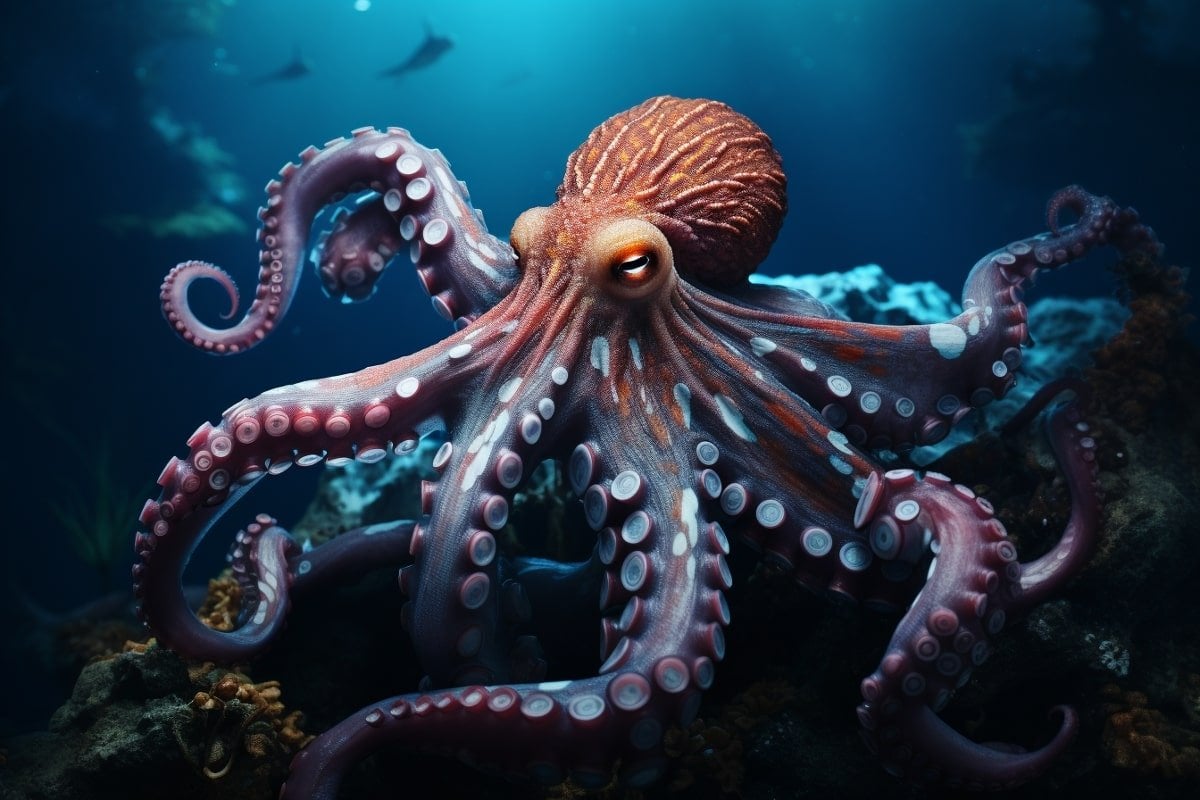Summary: Researchers mapped neural activity in an octopus’s visual system, revealing striking similarities to humans.
The team observed neural responses to light and dark spots, thereby creating a map resembling the organization of the human brain. Interestingly, octopuses and humans last shared a common ancestor around 500 million years ago, suggesting independent evolution of such complex visual systems.
These findings contribute greatly to our understanding of cephalopod vision and brain structure.
Key Facts:
- About 70% of an octopus’s brain is dedicated to vision. This research is the first to map the neural activity in their visual system, providing insights into how these marine creatures perceive their world.
- Despite a shared ancestor 500 million years ago, octopuses and humans have evolved similar neural maps for visual perception.
- The study discovered that octopus neurons respond strongly to small light spots and big dark spots, differing from the human visual system. This is potentially due to the specifics of the underwater environment.
Source: University of Oregon
An octopus devotes about 70 percent of its brain to vision. But until recently, scientists have only had a murky understanding of how these marine animals see their underwater world. A new University of Oregon study brings the octopus’s view into focus.
For the first time, neuroscientists have recorded neural activity from the visual system of an octopus. They’ve created a map of the octopus’s visual field by directly observing neural activity in the animal’s brain in response to light and dark spots in different locations.
This map of the neural activity in the octopus visual system looks a lot like what’s seen in the human brain — even though octopuses and humans last shared a common ancestor some 500 million years ago, and octopuses have evolved their complex nervous systems independently.
UO neuroscientist Cristopher Niell and his team report their findings in a paper published June 20 in Current Biology.
“Nobody has actually recorded from the central visual system of a cephalopod before,” Niell said. Octopuses and other cephalopods aren’t typically used as a model for understanding vision, but Niell’s team is fascinated by their unusual brains.
In a related paper published last year in Current Biology, the lab identified different categories of neurons in the octopus optic lobe, the part of the brain dedicated to vision. Together, “these papers provide a nice foundation by elucidating the different types of neurons and what they respond to — two essential aspects we’d want to know to start understanding a novel visual system,” Niell said.
In the new study, researchers measured how neurons in the octopus visual system responded to dark and light spots moving across a screen. Using fluorescent microscopy, the researchers could watch the activity of neurons as they responded, to see how neurons reacted differently depending on where the spots appeared.
“We were able to see that each location in the optic lobe responded to one location on the screen in front of the animal,” Niell said. “If we moved a spot over, the response moved over in the brain.”
This kind of one-to-one map is found in the human brain for multiple senses, like vision and touch. Neuroscientists have connected the location of particular sensations to specific spots in the brain.
A well-known representation for touch is the homunculus, a cartoon human figure in which body parts are drawn in proportion with how much brain space is devoted to processing sensory input there.
Highly sensitive spots like fingers and toes appear massive because there are lots of brain inputs from these body parts, while less sensitive areas are much smaller.
But finding an orderly linkage between the visual scene and the octopus brain was far from a given. It’s a fairly complex evolutionary innovation, and some animals such as reptiles don’t have that kind of map. Also, previous studies had suggested the that octopuses do not have a homunculus-like map for different parts of their body.
“We hoped that the visual map might be there, but nobody had directly observed it before,” Niell said.
The octopus neurons also responded particularly strongly to small light spots and big dark spots, the researchers noted — a distinct difference from the human visual system. Niell’s team hypothesizes that this might be due to the specific characteristics of the underwater environment that octopuses must navigate. Looming predators might appear as large dark shadows, while close-up objects like food would appear as small bright spots.
Next, the researchers hope to understand how the octopus brain responds to more complex images, such as those actually encountered in their natural environment. Their eventual goal is to trace the path of these visual inputs deeper into the octopus brain, to understand how the octopus sees and interacts with its world.
About this visual neuroscience research news
Author: Molly Blancett
Source: University of Oregon
Contact: Molly Blancett – University of Oregon
Image: The image is credited to Neuroscience News
Original Research: Open access.
“Functional organization of visual responses in the octopus optic lobe” by Cristopher Niell et al. Current Biology
Abstract
Functional organization of visual responses in the octopus optic lobe
Highlights
- The functional organization of the cephalopod visual system is largely unknown
- Using calcium imaging, we mapped visually evoked responses in the octopus optic lobe
- We identified spatially localized receptive fields with retinotopic organization
- ON and OFF pathways were distinct and had unique size selectivity properties
Summary
Cephalopods are highly visual animals with camera-type eyes, large brains, and a rich repertoire of visually guided behaviors. However, the cephalopod brain evolved independently from those of other highly visual species, such as vertebrates; therefore, the neural circuits that process sensory information are profoundly different.
It is largely unknown how their powerful but unique visual system functions, as there have been no direct neural measurements of visual responses in the cephalopod brain.
In this study, we used two-photon calcium imaging to record visually evoked responses in the primary visual processing center of the octopus central brain, the optic lobe, to determine how basic features of the visual scene are represented and organized.
We found spatially localized receptive fields for light (ON) and dark (OFF) stimuli, which were retinotopically organized across the optic lobe, demonstrating a hallmark of visual system organization shared across many species.
An examination of these responses revealed transformations of the visual representation across the layers of the optic lobe, including the emergence of the OFF pathway and increased size selectivity.
We also identified asymmetries in the spatial processing of ON and OFF stimuli, which suggest unique circuit mechanisms for form processing that may have evolved to suit the specific demands of processing an underwater visual scene.
This study provides insight into the neural processing and functional organization of the octopus visual system, highlighting both shared and unique aspects, and lays a foundation for future studies of the neural circuits that mediate visual processing and behavior in cephalopods.








